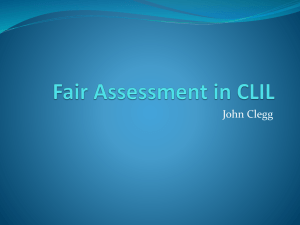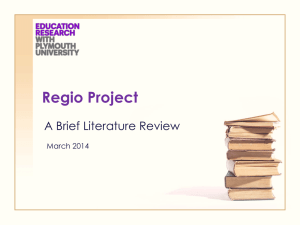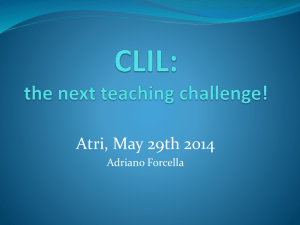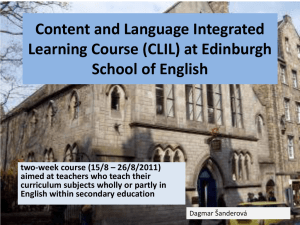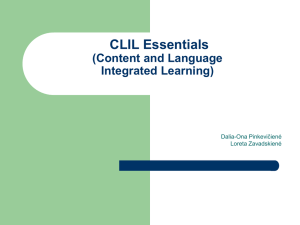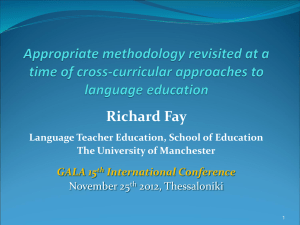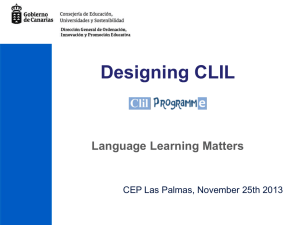Learning and Assessment in CLIL
advertisement
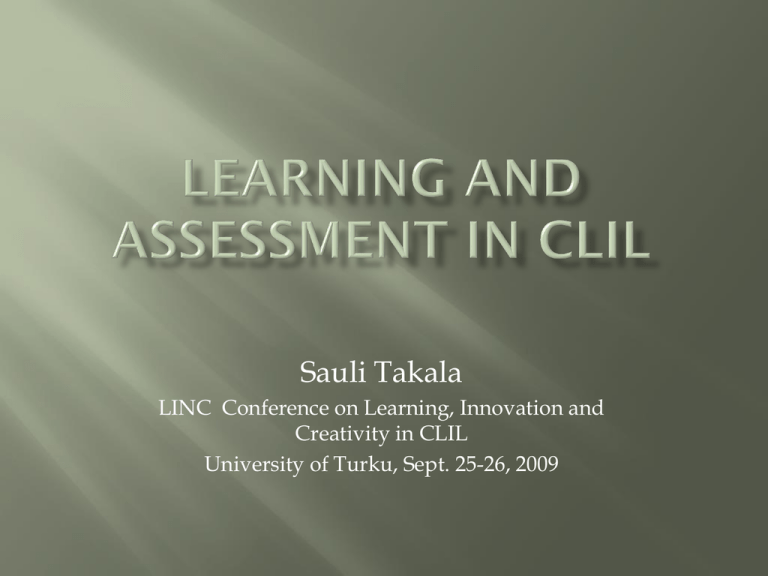
Sauli Takala LINC Conference on Learning, Innovation and Creativity in CLIL University of Turku, Sept. 25-26, 2009 •Overview • xxx •Xxx •Xxx •Xxx •xxx Alignment refers to the degree of match between test content and the standards Goals, instruction and assessment need to be aligned Dimensions of alignment, eg. Content Depth Emphasis Cf The Mikado (Gilbert & Sullivan): My object all sublime, I shall achieve in time- To let the punishment fit the crime, The punishment fit the crime CLIL is both similar and different from other instruction Differences - CLIL classrooms use as a medium of instruction and classroom interaction a language (L2) in which the learners’ (and usually also the teachers’) level of proficiency is somewhat or even considerably lower than in their L1 - This represents a double burden: the need to learn both new content and to use their available language resources effectively to understand and produce meanings in L2 , and continously develop their resources - It is likely that both learners and teachers need to develop their strategic competence beyond what would be adequate in non-CLIL classrooms - It is also likely that pupils/students need to develop their linguistic awareness and their comprehension-monitoring beyond what would be normally needed - It is likely that students in CLIL classrooms need more tolerance for ambiguity, more stress-tolerance and a higher anxiety threshold CLIL is both similar and different from other instruction Similarities - CLIL classrooms are institutional educational contexts like other classrooms - The cultural context is the same (L1 matrix culture) - Pupils and students usually have extensive prior experience of learning and studying in classrooms - CLIL instruction has predetermined content (curriculum) like other - Such basic similarities help in may ways teaching/learning in CLIL programmes Content is conveyed in communication and using language. Academic content is presented using both general and subjectspecific discourse. Thus it makes sense to pay attention to the ways discourse is implemented in different subjects. -> CLIL teachers need to know and learn to use consciously the basic discourse/genre conventions in their subject Thus it seems to me highly useful to have what Lyster (2007), and others, advocate for CLIL: a “counterbalanced approach”. There is therefore a need to combine content-focused and languagefocused elements in a well planned curriculum/program/course. There should be goals defined both for content and language learning (cf. Rauto & Saariaho at this conference) There is a need for the teacher to provide at suitable intervals coherent, longer descriptions, explanations etc in order to provide input of longer academic talk (develop comprehension for further knowledge acquisition via L2) This also applies to students: they need to be challenged to provide also longer oral responses and write longer texts What the classroom context can do is to create a community with its own cultural reality, with its own conventions of what is feasible and appropriate,… such a context is bound to set limits on what language learners are explicitly taught, and these cannot of their nature contain “real world communication.” But the crucial point is that this is not language to be learned as such, but language to be learned from (Widdowson 1998, 33) Cf however, modern IT technology, virtuality is providing new opportunities to join a community which is external to the normal school context Questions play an important role in the CLIL classroom (as in other classrooms) How do questions condition the discourse patterns which are possible in CLIL classroom interaction? How do questions influence the quality and quantity of students´ contribution to classroom talk? Display questions/referential questions Closed questions/Open questions Questions -of facts - for explanations -for reasons - for opinion Comprehension checks, clarification requests, confirmation checks Some major academic language functions Analyzing Classifying Comparing Defining Describing Drawing conclusions Evaluating & assessing Explaining Informing Narrating Persuading Predicting Requesting/giving information Hypothesizing CLIL teachers would benefit from knowing and systematically using typical L2 expressions used for such functions. Informing Narrating Persuading Predicting Requesting/giving information Hypothesizing CLIL teachers would benefit from knowing and systematically using typical L2 expressions used for such functions. Informing Narrating Persuading Predicting Requesting/giving information Hypothesizing CLIL teachers would benefit from knowing and systematically using typical L2 expressions used for such functions. Content counts but also language counts Therefore a ”counterbalanced approach” is desirable for optimal impact of CLIL. Not just rich input, trusting language proficiency to improve through it, but also focus on developing language resources. Types of assessment (purposes) Asessment of CLIL instruction (what happens….) Assessment in CLIL instruction (main focus in this presenatation) Assessment for CLIL instruction (formative, diagnostic) Who assesses? Assessment by teachers (in/for CLIL instruction) Assessment by learners in CLIL instruction (process, outcome, self-assessment/monitoring Assessment by peers Like CLIL instruction, assessment in CLIL is basically similar to assessment in other subjects. Assessment in CLIL needs to fulfil the same quality criteria as assessment in general Assessment is a procedure to elicit/describe examinee behaviour in a specific domain of content. All assessment, and assessment in CLIL is no exception, has to fulfil general quality criteria. Two of these are the most essential: validity and reliability. Both refer to the quality of the assessment activity, not in the first instance to the test/assessment instruments. A test is not valid/reliable: what may be valid/reliable are assessment/test score – “tests in action” The validity and reliability of assessment is also context-dependent: therefore all tests and other assessment procedures have to be appropriate for the context. Validity refers to the validity of interpretations of test/assessment outcomes. Are the interpretations, decisions, actions based on the assessment justified by the evidence collected and are they supported by what is the current theoretical view of the knowledge, skills, competencies, attitudes etc.(“construct”) assessed? Assessment is valid if the assessment procedures are on target, that is, they focus on the construct and display a minimal influence of construct-irrelevant factors. Valid tests measure what they are intended to measure. Reliability is a related concept but is not synonymous with validity . It takes into account the fact that all assessment/testing contains some potential for errors of various kind. The smaller the part of error the more reliable is the assessment. As mentioned in the above, assessment is a procedure to elicit/describe examinee behaviour in a specific domain of content. An essential part of the procedure is the scoring/rating guidelines, which enable the examiner to quantify, evaluate and interpret that behaviour (performance). Reliable assessment is accurate, precise and consistent: the same or similar performance is rated (almost or roughly) the same (a) if the assessment is repeated and (b) if different raters judge it independently of each other. A third general quality standard refers to fairness in assessment and the use of assessment. Like validity and reliability, fairness is related to the whole process of assessment. Fairness is a complex question and there are different views of fairness. The absence, or adequate control, of bias in favour of some individuals/groups in terms of content, assessment method, assessment conditions etc is an important requirement. In addition to these general quality standards, assessment needs to be responsive to the pragmatic considerations: cost, time, effectiveness and efficiency, in short practicality and usefulness. Forms of assessment Teacher obervation/continuous assessment observation form, checklists, logs, diaries Assessment instuments: classwork, projects, portfolio, quizzes, tests Self-assessment, peer assessment Assessments should provide evidence of desired competences performances achievements consequences While acknowledging cultural differences individual differences available capacities, resources, and opportunities In ways that are valid (content and purpose is specified, and proved to be fulfilled without irrelevant factors or unintended negative consequences) reliable (consistent, comparable, equitable, and fair) feasible (manageable, comprehensible, and relevant) Diagnosis and Planning Achievement Formal and Feedback Certification (Alister Cumming, 2009) Curriculum Resources Learning Communication opportunities Taught \/ Studied or practiced \/ Achieved External, normative standards Official recognition Needs analysis (initial and cyclic) Self Assessments Goals for learning Short-term Performance Activities Tasks Records Observations Tests Long-term Performance Accumulative, summative records Tests Institutional requirements Communication tasks Surveys Personal aims Diagnosis of special needs Pedagogical Activities Tasks Assignments Exercises Observations Responses (oral and written) Tests Reflective Tools Logs Records Portfolios Self-assessment
